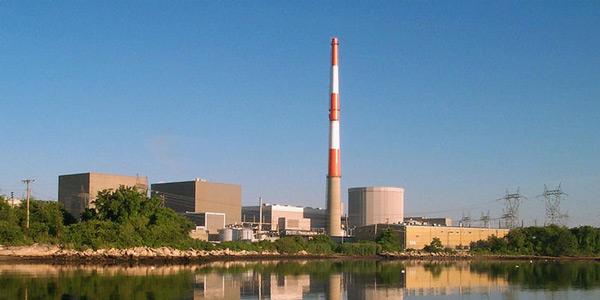By Michael Kuser
Connecticut Gov. Dannel Malloy on Tuesday ordered state regulators to assess the economic viability of the Millstone nuclear power plant and determine whether the state should provide it financial support. Millstone supplies about half of Connecticut’s electricity.
The Connecticut General Assembly in June failed to pass a bill that would have allowed the 2,111-MW nuclear plant in Waterford to bid into the state procurement process (S.B. 106). Millstone owner Dominion Energy had sought the legislation to boost the plant’s revenues, which have suffered from low-priced natural gas. Gas-fired generators often set LMPs in New England.
Malloy’s executive order also directs the state Department of Energy and Environmental Protection and the Public Utilities Regulatory Authority to assess the role of large-scale hydropower, demand-reduction measures, energy storage and emissions-free renewable energy in helping Connecticut meet its ambitious targets to cut its carbon output.
The state’s Global Warming Solutions Act of 2008 mandates cutting greenhouse gas emissions to 10% below 1990 levels by 2020, and to 80% below 2001 levels by 2050.
Show us the Books
The governor’s July 25 order directed DEEP and PURA to use “the best available information, including such facilities’ audited financial statements and such other financial data that is reasonably requested by [regulators]” in their economic analysis of Millstone.
Matt Fossen, spokesman for the Stop the Millstone Payout coalition, said “it is essential that Dominion fully disclose the plant-level financials of Millstone; otherwise the investigation won’t be truly comprehensive or accurate.”
The coalition — sponsored by competitors Calpine, Dynegy and NRG Energy and the Electric Power Supply Association (EPSA) — had argued S.B. 106 would be a burden on ratepayers and an unnecessary handout to a power plant that had not been proven to be unprofitable.
The group in April released a study by energy consultancy Energyzt that showed the Millstone plant has earned at least $3 billion in profits since Dominion bought it in 2001 and will likely earn an additional $2.2 billion in after-tax income from now through 2030. Dominion spokesman Ken Holt criticized the Energyzt report as “loaded with gross assumptions and preposterous claims, with no real data.” (See Millstone No Dead Weight for Dominion, Says Opponents’ Study.)
New York ZEC Suit Dismissed
The legislation would have made Millstone the only eligible nuclear generator in Connecticut’s competitive bidding process and awarded it a five-year contract if it bid lower than competing renewable resources. The bill would have set an annual limit on nuclear energy purchases at 8.3 million MWh, equivalent to half of Millstone’s output.
The Connecticut measure would have been similar in effect to the zero-emission credit programs that EPSA and its members are contesting in New York and Illinois.
Also Tuesday, a federal judge in New York dismissed all claims in the suit against the state’s ZEC program. (See Illinois Zero-Emission Credit Suit Dismissed.)
EPSA and its members in Illinois on July 17 filed an appeal with the 7th U.S. Circuit Court of Appeals. They argued they stood to lose millions because the subsidized nuclear plants would suppress capacity and energy prices. The plaintiffs are expected to also appeal the New York decision to the 2nd Circuit.


